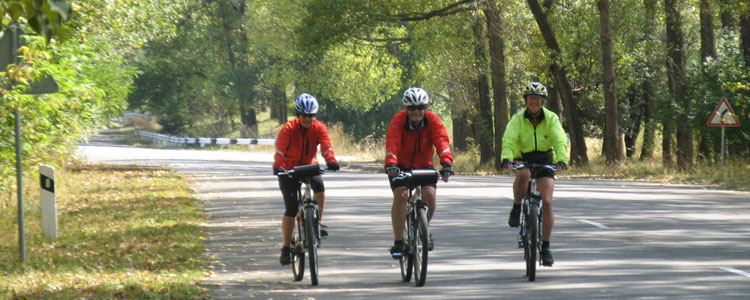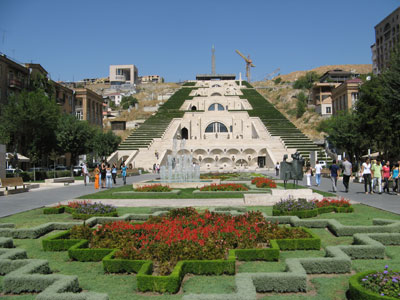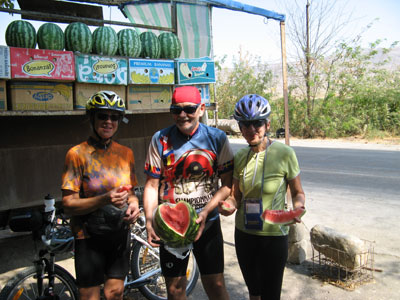Bicycling the back roads of Armenia
by Ann Abeles; Frederick, MD. Photos by Fred Abeles
Two friends accompanied my husband, Fred, and me on a 10-day bicycle tour of Armenia in September ’10. We found the trip description on the Web and e-mailed the company, AdvenTour (Yerevan, Armenia; phone +374 1048 22 71), with questions. It sounded like a trip we could handle, especially since a van and driver would be accompanying us in case anyone needed a lift.
Trip preparations
Before we left, I purchased the third edition (2008) of the Lonely Planet guide to Georgia, Armenia and Azerbaijan and sliced out the section on Armenia, which fit easily in my waist pack.
We also purchased “The Roads of Armenia Map” ($13.95 plus tax and shipping) from OMNI Resources (Burlington, NC; 800/742-2677). This map was compact and showed the distance between towns in kilometers at a scale that was adequate for navigating our trip (1 cm = 5 km).
In addition to clothing, we brought our helmets, biking shoes, clipless pedals, bike seats, an inexpensive bike computer (to help keep track of our distances) and under-the-seat bike bags, which contained a small tire pump, tire levers, patches, a multi-tool, a first-aid kit, insect repellent, hand sanitizer and so forth.
We left Washington Dulles Airport on Sept. 7 and arrived in Yerevan around 9:30 the next night. After clearing Customs and purchasing our visas ($14 each), we met our driver/guide for the next two weeks, Ara Hakobyan. Ara helped us with our luggage, drove us to our hotel and got us checked in.
Exploring Yerevan
The next morning we met up with our friends Art and Julane for breakfast, then headed out to explore Yerevan and reset our internal clocks to Armenian time. We followed Lonely Planet’s suggested walking tour of central Yerevan but in the opposite direction, since our hotel was located near the end of the suggested tour.
The walk gave us a good overview of central Yerevan and included a walk around Republic Square; the Katoghike, a pretty, centuries-old chapel; the Opera House, and the Zoravar Church.
Next we climbed the hill to the Matenadaran, a repository of Armenian books and manuscripts. There we viewed part of the huge collection of beautifully illuminated manuscripts produced by Armenian scribes for more than 1,000 years.
After a pizza lunch, we visited the new Cafesjian Center for the Arts at the Cascade. The building, itself, is a beautifully constructed “stairway” of gardens and exhibit rooms built on the hillside below a monument to Soviet Armenia.
We continued our stroll along Baghramian Avenue as far as the National Academy of Sciences building and then decided to take Yerevan’s metro back to Republic Square. We were surprised that the fare was only AMD50 (about 14¢) per person.
Before returning to our hotel, we walked the several blocks from the metro station to the Blue Mosque, built in 1765. In the 1990s, a group from Iran began restoring the mosque, and work is still ongoing on the dome, in the madrasah and in the gardens around the mosque.
That evening, we walked up the street a few blocks from our hotel to Caucasus Tavern (82 Hanrapetutoutian St.), a restaurant recommended by our hotel staff and Lonely Planet. We ordered five different Armenian dishes to share, along with bread and hummus. The meal for four, including drinks, cost about $25.
On the road
September 10 marked the start of our tour. When Ara arrived after breakfast, we checked out of our hotel and loaded our gear into the Toyota SUV.
Ara drove us out of Yerevan to our first monastery, Khor Virap, near the border with Turkey. It had a good view of Mt. Ararat, a mountain sacred to Armenia that now lies within Turkey due to a border change in 1932.
This monastery is where St. Gregory the Illuminator was held prisoner in a deep pit by King Trdat III for 13 years. The king went mad and was told that Gregory could restore his sanity; he did. The king was so grateful that he released Gregory and became a Christian, declaring Armenia a Christian country in AD 301.
The various buildings and churches in the complex have been rebuilt several times since the seventh century. The main church dates from the 17th century.
When we returned to the parking lot, we unloaded our bicycles, put our gear on them and set off down to the main road, heading south along the Araks River valley.
We passed many fruit stands, with the vendors all offering us delicious fruit, so Ara suggested we stop for some watermelon. We stood in the shade along the road, carving out chunks of melon with Art’s Swiss Army knife and slurping up the sweet, juicy melon.
Between Ararat and Yeraskhavan we also passed several large fish ponds, situated between the road and the Araks River, plus stalls and fish tanks along the road advertising the fresh fish for sale.
After Yeraskhavan, we loaded the bikes onto the van and were driven over the Tukh Manuk Pass (1,795 meters) to a winery outlet in Yeghegnadzor that Ara said carried good Areni wines.
Ara said the route from there was mostly downhill and described where we would find our hotel for the night in Vayk (14 kilometers farther down the road). Julane and Fred were done biking for the day, so Ara took them to the hotel while Art and I continued by bike to Vayk.
The daily routine
The next days of the tour followed a similar plan. After breakfast at our hotel, Julane and I would pack a small picnic lunch (if we knew there was no convenient place to stop along the day’s route) and make sure we had several liters of water in the van.
We would bike, tour interesting places, bike and be driven to our next night’s lodging. We toured the Noravank Monastery and Areni Winery in Vayots Dzor Marz (Province); the Tatev Monastery in Syunik Marz; the Selim Caravansary on the way to Lake Sevan; the Tavush Marz and its capital, Ijevan; the Haghpat and Sanahin monasteries, and Stepanavan and Lori Berd in the Lori Marz.
The isolated Tatev Monastery was especially noteworthy. Future visitors will have a much easier time reaching it via the new cable car over the Vorotan River that was inaugurated in October ’10, after our visit.
On most days we biked only 18 to 20 miles because we stopped so often to take pictures, look at things at roadside stands and tour the monasteries and historic sights. Most roads were paved and clean, with light traffic.
The details
Our lodgings ranged from modern hotels, like the Best Western Bohemian on Lake Sevan, to a remodeled farmhouse in the village of Akner near Alaverdi.
Our evening meals were in restaurants, either in the town or at our hotel, except at the farmstay, where the host and his daughter-in-law prepared a typical home-cooked meal of traditional dishes, such as stuffed peppers. The food was always good and the water safe to drink.
We never felt threatened or unsafe and, in fact, found the Armenians to be generous, friendly and very curious about a group of Americans “bicycling” around their country.
The per-person cost for our 10-day tour was €890 ($1,260). Bicycle rental cost €105 ($149), and the round-trip transfer from the airport to the hotel in Yerevan cost €28 per person.
Our extra nights in Yerevan cost €72 per night, double. Travel insurance from iTravel Insured (Indianapolis, IN; 866/347-6673) cost $139 per person.
All breakfasts and one evening meal were included in the tour price. We discovered that, most of the time, we could pack lunches of cheese-and-vegetable sandwiches from our breakfast leftovers, since we seldom passed lunch places while riding.
We spent about $310 on food and snacks for the two of us for 11 days, or about $14 per person per day, including wine or beer.
Museum entries, taxi and metro rides, postcards and pay potties cost another $25-$30, bringing the total cost of our trip for two to about $6,600 (including international air).




